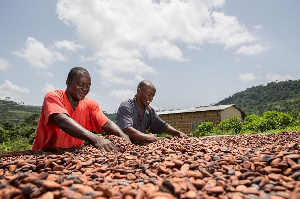The global cocoa market experienced a surge in prices during April 2023, reaching a six-year high in both the London and New York markets, according to the April 2023 cocoa report by the International Cocoa Organization (ICCO).
Prices of the front-month [May 2023] cocoa futures contract rose by 5 percent in London from US$2,630 to US$2,773 per tonne, and by 11 percent in New York from US$2,868 to US$3,177 per tonne for the May-23 contract.
ICCO highlighted various factors that contributed to the upward trend in cocoa prices, on the back of concerns over the availability of cocoa beans and weather-related challenges in key cocoa-producing regions.
There has been a global supply deficit resulting from a low level of cocoa bean supply from West Africa, particularly Côte d’Ivoire. This deficit played a significant role in triggering the price hikes. Cocoa farmers continue to struggle with lack of fertiliser and pesticides as the war in Ukraine has limited Russian exports of potash and other fertiliser worldwide.
“On one hand, the persisting spectrum of a global supply deficit that resulted from the current year-on-year low level of cocoa beans’ supply from West Africa contributed to triggering the price hikes. On the other hand, the abundant rains that were recorded in Côte d’Ivoire’s main cocoa-growing regions raised concerns over a possible delay of the country’s mid-crop,” ICCO mentioned.
“The excess humidity in cocoa plantations stemming from the massive rains in cocoa growing areas heightened the likelihood of a potential outbreak of the black pod disease, which is detrimental to the crop,” the report added.
Production
ICCO notes that available information on crop sizes in main cocoa-origin countries in West Africa suggests that compared to the 2021/22 cocoa year, the 2022/23 cocoa season is heading toward a supply deficit due to a reduction in production.
The current year-on-year reduction of 137,000 tonnes for cumulative arrivals in Côte d’Ivoire combined with the year-on-year increase of 53,013 tonnes in Ghana and 6,286 tonnes in Brazil resulted in a shortfall of 77,701 tonnes of cocoa beans. This decline represents a larger reduction of over seven times the year-on-year decline of 10,672 tonnes observed in grindings for the three main regional cocoa associations during the first-half of 2022/23 year.
Indeed, as of the end of April 2023, arrivals at Côte d’Ivoire ports of exports were reported to lag behind volumes recorded during the corresponding period of the previous season. By 7 May 2023, cumulative arrivals of cocoa beans in the country were seen at 1.945 million tonnes, down by 7.04 percent (-137,000 tonnes) compared to 2.082 million tonnes seen over same period of the previous cocoa year.
In addition, the country’s exports of cocoa beans from October 2022 to March 2023 were reported at 1,005,510 tonnes, slightly down by 0.5 percent compared to 1,010,080 tonnes exported from October 2021 to March 2022.
In Ghana, the production of cocoa beans in 2022/23 is envisaged to overtake the level recorded during 2021/22. The latest information indicates that the volumes of graded and sealed cocoa beans purchased in Ghana were estimated at 576,738 tonnes from October 2022 to March 2023, up by 10.1 percent (+53,013 tonnes) compared with 523,725 tonnes purchased during the previous season’s corresponding period.
In Brazil, the cocoa production data published by AIPC indicated that over the first six months of the 2022/23 cocoa season, the Brazilian cocoa crop output reached 79,313 tonnes, up by 9 percent year-on-year (+ 6,286 tonnes) compared to 73,027 tonnes.
Source: thebftonline.com
 Home Of Ghana News Ghana News, Entertainment And More
Home Of Ghana News Ghana News, Entertainment And More




